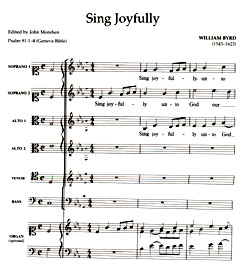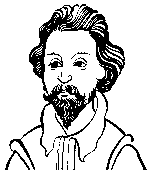William Byrd (1543 - 1623)
BACKGROUND
AND HISTORICAL PERSPSECTIVE
By:
Jason R. Ogan
|
|
|
The greatest English
composer of his generation, comparable in stature to his most distinguished
continental contemporaries, William Byrd was a versatile composer. Although
remaining a Catholic, loyalty that cost him considerable trouble in
times of persecution in England, he served as a member of the Chapel
Royal, providing music for the liturgy of the Church of England and,
on a more private scale, for his fellow-Catholics.
|
Biographical Information on William Byrd
Links
CHURCH MUSIC
Byrd's compositions for the church can be
separated into two categories; those for the Catholic liturgy and those designed
for the officially recognised Church of England. The first category includes
settings of the Mass for three, four and five voices, and a large quantity of
other works for the various seasons of the church year.
For the Church of England Byrd wrote a Great
Service and three other service settings, using the texts of the Anglican liturgy.
In addition to the above compositions Byrd composed a
number of anthems and psalm-settings, and consort songs with sacred texts of
one sort or another.
VOCAL MUSIC
Byrd also wrote a number of secular consort songs. These
are songs with accompaniment entrusted to varying numbers of instruments.
CONSORT MUSIC
Not unlike the popular music of the time, Byrd provided
music for various groups of instruments. These were usually works for Viols.
Bowed and fretted string instruments were held in high social esteem. Byrd's
consort music includes a number of In nomines, a curious English form of music
based on fragment taken from a setting of the Benedictus by the 16th century
composer Taverner. Byrd also composed a series of Fantasias and a great deal
of contrapuntal instrumental music.
KEYBOARD MUSIC
Byrd was well known as a keyboard-player. He wrote a
wealth of music for the virginals, Fantasias, Pavans and Galliards, the fashionable
paired dances of the time, and several song variations. The Earl of Salisbury
Pavan and Galliard is a familiar recital piece as are the Variations
on Sellinger's Round and The Carman's Whistle.
ADDITIONAL
BIOGRAPHICAL INFORMATION ON THIS IMPORTANT COMPOSER
Most likely born in Lincolnshire in 1543, Byrd was the foremost English composer
of his time. As a student of Thomas Tallis he was exposed to music of the Chapel
Royal and the best of the English tradition. In 1563 he was appointed organist
of Lincoln Cathedral, and by 1572 joined the Chapel Royal where he shared organist
duties with Tallis. The relationship between Tallis and Byrd was personal as
well as professional and in 1575 they jointly published Cantiones Sacrae. In
this publication are 34 motets dedicated to Elizabeth I. Although Byrd was a
Catholic in Protestant England, he had no problems with his superiors. Many
of his patrons, such as the Earl of Worcester, were Catholics as well, and when
England momentarily returned to Roman Church he had no shortage of music to
accompany the revival; he had been composing music for underground catholic
circles for years. He composed for every branch of music; Consort, Sacred, Keyboard
music. He left no instrument without a piece of his music. Byrd's last publication
was Psalmes, Songs and Sonnets and was published in 1611. He died in 1623. Byrd's
music would go on to affect and shape much of later English music. He music
shows the impressions of the Italian, Palestrina, and the Spainish school, Vittoria.
 Example
of the music of William Byrd. "Sing Joyfully" is one of the most widely
known
Example
of the music of William Byrd. "Sing Joyfully" is one of the most widely
known
and performed works by William Byrd.
To hear an excerpt from Williams Byrd's "Ave verum corpus" click
here.
Other interesting links:
The William Byrd Competition
MIDI Page
Choral Net
Cantores in Ecclesia
This page was designed and edited my Jason R. Ogan

 Example
of the music of William Byrd. "Sing Joyfully" is one of the most widely
known
Example
of the music of William Byrd. "Sing Joyfully" is one of the most widely
known